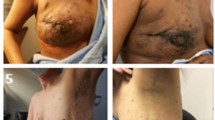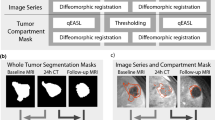Abstract
Although the liver possesses a dual blood supply, arterial vessels deliver only a small proportion of blood to normal parenchyma, but they deliver the vast majority of blood to primary and secondary cancers of the liver. This anatomical discrepancy is the basis for intra-arterial brachytherapy of liver cancers using radioactive microspheres, termed radio-embolization (RE). Radioactive microspheres implant preferentially in the terminal arterioles of tumors. Although biological models of the flow dynamics and distribution of microspheres are currently in development, there is a need to improve the imaging biomarkers of flow dynamics used to plan RE. Since a direct consequence of RE is vascular disruption and necrosis, we suggest that imaging protocols sensitive to changes in vasculature are highly likely to represent useful early biomarkers for treatment efficacy. We propose dynamic contrast-enhanced CT as the most appropriate imaging modality for studying vascular parameters in clinical trials of RE treatment.
This is a preview of subscription content, access via your institution
Access options
Subscribe to this journal
Receive 12 print issues and online access
$209.00 per year
only $17.42 per issue
Buy this article
- Purchase on SpringerLink
- Instant access to full article PDF
Prices may be subject to local taxes which are calculated during checkout




Similar content being viewed by others
References
Kennedy, A. et al. Recommendations for radioembolization of hepatic malignancies using yttrium-90 microsphere brachytherapy: a consensus panel report from the radioembolization brachytherapy oncology consortium. Int. J. Radiat. Oncol. Biol. Phys. 68, 13–23 (2007).
Kennedy, A. S., Nutting, C., Coldwell, D., Gaiser, J. & Drachenberg, C. Pathologic response and microdosimetry of (90)Y microspheres in man: review of four explanted whole livers. Int. J. Radiat. Oncol. Biol. Phys. 60, 1552–1563 (2004).
Kennedy, A. S. et al. Treatment parameters and outcome in 680 treatments of internal radiation with resin 90Y-microspheres for unresectable hepatic tumors. Int. J. Radiat. Oncol. Biol. Phys. 74, 1494–1500 (2009).
Nicolay, N. H., Berry, D. P. & Sharma, R. A. Liver metastases from colorectal cancer: radioembolization with systemic therapy. Nat. Rev. Clin. Oncol. 6, 687–697 (2009).
Flamen, P. et al. Multimodality imaging can predict the metabolic response of unresectable colorectal liver metastases to radioembolization therapy with Yttrium-90 labeled resin microspheres. Phys. Med. Biol. 53, 6591–6603 (2008).
Dhabuwala, A., Lamerton, P. & Stubbs, R. S. Relationship of 99mtechnetium labelled macroaggregated albumin (99mTc-MAA) uptake by colorectal liver metastases to response following Selective Internal Radiation Therapy (SIRT). BMC Nucl. Med. 5, 7 (2005).
Dancey, J. E. et al. Treatment of nonresectable hepatocellular carcinoma with intrahepatic 90Y-microspheres. J. Nucl. Med. 41, 1673–1681 (2000).
Kennedy, A. S., Kleinstreuer, C., Basciano, C. A. & Dezarn, W. A. Computer modeling of yttrium-90-microsphere transport in the hepatic arterial tree to improve clinical outcomes. Int. J. Radiat. Oncol. Biol. Phys. 1, 631–637 (2010).
Hong, K., Georgiades, C. S. & Geschwind, J. F. Technology insight: Image-guided therapies for hepatocellular carcinoma--intra-arterial and ablative techniques. Nat. Clin. Pract. Oncol. 3, 315–324 (2006).
Mabotuwana, T. D., Cheng, L. K. & Pullan, A. J. A model of blood flow in the mesenteric arterial system. Biomed. Eng. Online 6, 17 (2007).
Basciano, C. A., Kleinstreuer, C., Kennedy, A. S., Dezarn, W. A. & Childress, E. Computer modeling of controlled microsphere release and targeting in a representative hepatic artery system. Ann. Biomed. Eng. 38, 1862–1879 (2010).
Eisenhauer, E. A. et al. New response evaluation criteria in solid tumours: revised RECIST guideline (version 1.1). Eur. J. Cancer 45, 228–247 (2009).
Michaelis, L. C. & Ratain, M. J. Measuring response in a post-RECIST world: from black and white to shades of grey. Nat. Rev. Cancer 6, 409–414 (2006).
Boppudi, S., Wickremesekera, S. K., Nowitz, M. & Stubbs, R. Evaluation of the role of CT in the assessment of response to selective internal radiation therapy in patients with colorectal liver metastases. Australas. Radiol. 50, 570–577 (2006).
Gerstner, E. R., McNamara, M. B., Norden, A. D., Lafrankie, D. & Wen, P. Y. Effect of adding temozolomide to radiation therapy on the incidence of pseudo-progression. J. Neurooncol. 94, 97–101 (2009).
Curley, S. A. et al. Radiofrequency ablation of unresectable primary and metastatic hepatic malignancies: results in 123 patients. Ann. Surg. 230, 1–8 (1999).
Wolchok, J. D. et al. Guidelines for the evaluation of immune therapy activity in solid tumors: immune-related response criteria. Clin. Cancer Res. 15, 7412–7420 (2009).
Wong, C. Y., Salem, R., Raman, S., Gates, V. L. & Dworkin, H. J. Evaluating 90Y-glass microsphere treatment response of unresectable colorectal liver metastases by [18F]FDG PET: a comparison with CT or MRI. Eur. J. Nucl. Med. Mol. Imaging 29, 815–820 (2002).
Marn, C. S. et al. Hepatic parenchymal changes after intraarterial Y-90 therapy: CT findings. Radiology 187, 125–128 (1993).
Sharma, R. A. et al. Radioembolization of liver metastases from colorectal cancer using yttrium-90 microspheres with concomitant systemic oxaliplatin, fluorouracil, and leucovorin chemotherapy. J. Clin. Oncol. 25, 1099–1106 (2007).
Sato, K. T. et al. The role of tumor vascularity in predicting survival after yttrium-90 radioembolization for liver metastases. J. Vasc. Interv. Radiol. 20, 1564–1569 (2009).
Riaz, A. et al. Radiologic-pathologic correlation of hepatocellular carcinoma treated with internal radiation using yttrium-90 microspheres. Hepatology 49, 1185–1193 (2009).
Miller, F. H. et al. Response of liver metastases after treatment with yttrium-90 microspheres: role of size, necrosis, and PET. AJR Am. J. Roentgenol. 188, 776–783 (2007).
Keppke, A. L. et al. Imaging of hepatocellular carcinoma after treatment with yttrium-90 microspheres. AJR Am. J. Roentgenol. 188, 768–775 (2007).
Choi, H. et al. CT evaluation of the response of gastrointestinal stromal tumors after imatinib mesylate treatment: a quantitative analysis correlated with FDG PET findings. AJR Am. J. Roentgenol. 183, 1619–1628 (2004).
Tofts, P. S. et al. Estimating kinetic parameters from dynamic contrast-enhanced T(1)-weighted MRI of a diffusable tracer: standardized quantities and symbols. J. Magn. Reson. Imaging 10, 223–232 (1999).
Eide, K. R. et al. DynaCT during EVAR--a comparison with multidetector CT. Eur. J. Vasc. Endovasc. Surg. 37, 23–30 (2009).
Jeon, U. B. et al. Iodized oil uptake assessment with cone-beam CT in chemoembolization of small hepatocellular carcinomas. World J. Gastroenterol. 15, 5833–5837 (2009).
Goh, V. & Padhani, A. R. Imaging tumor angiogenesis: functional assessment using MDCT or MRI? Abdom. Imaging 31, 194–199 (2006).
Mitsuzaki, K. et al. CT appearance of hepatic tumors after microwave coagulation therapy. AJR Am. J. Roentgenol. 171, 1397–1403 (1998).
Ohmoto, K., Tsuduki, M., Kunieda, T., Mitsui, Y. & Yamamoto, S. CT appearance of hepatic parenchymal changes after percutaneous microwave coagulation therapy for hepatocellular carcinoma. J. Comput. Assist. Tomogr. 24, 866–871 (2000).
Szyszko, T. et al. Assessment of response to treatment of unresectable liver tumours with 90Y microspheres: value of FDG PET versus computed tomography. Nucl. Med. Commun. 28, 15–20 (2007).
Wong, C. Y. et al. Reduction of metastatic load to liver after intraarterial hepatic yttrium-90 radioembolization as evaluated by [18F] fluorodeoxyglucose positron emission tomographic imaging. J. Vasc. Interv. Radiol. 16, 1101–1106 (2005).
Zahra, M. A., Hollingsworth, K. G., Sala, E., Lomas, D. J. & Tan, L. T. Dynamic contrast-enhanced MRI as a predictor of tumour response to radiotherapy. Lancet Oncol. 8, 63–74 (2007).
Hawighorst, H. et al. Angiogenic activity of cervical carcinoma: assessment by functional magnetic resonance imaging-based parameters and a histomorphological approach in correlation with disease outcome. Clin. Cancer Res. 4, 2305–2312 (1998).
Campbell, A. M., Bailey, I. H. & Burton, M. A. Analysis of the distribution of intra-arterial microspheres in human liver following hepatic yttrium-90 microsphere therapy. Phys. Med. Biol. 45, 1023–1033 (2000).
Acknowledgements
The concepts presented in this article were developed at the Tryst of Radio-Embolization Brachytherapy Leading Experts (TREBLE) meeting held in Trinity College, Oxford on 26 October 2009. The authors wish to thank the TREBLE participants: Boris Vojnovic, John Primrose, Eli Glatstein, David Berry, Peter Gibbs, Denny Liggitt, David Liu, Marc Peeters and Bruno Sangro. R. A. Sharma is funded by the Higher Education Funding Council for England and the Bobby Moore Fund of Cancer Research UK. R. A. Sharma and B. Jones acknowledge the support of the NIHR Biomedical Research Centre, Oxford, UK.
Author information
Authors and Affiliations
Contributions
B. Morgan, A. S. Kennedy and R. A. Sharma contributed to the data research, discussion, writing and reviewing/editing of the manuscript. V. Lewington and B. Jones contributed to the discussion and writing of the manuscript.
Corresponding author
Ethics declarations
Competing interests
A. S. Kennedy declares he receives grant/research support, is on the Speaker's Bureau and is a Consultant for Sirtex Medical. R. A. Sharma declares he receives grant/research support and is on the Speaker's Bureau for Sirtex Medical. The other authors declare no competing interests.
Rights and permissions
About this article
Cite this article
Morgan, B., Kennedy, A., Lewington, V. et al. Intra-arterial brachytherapy of hepatic malignancies: watch the flow. Nat Rev Clin Oncol 8, 115–120 (2011). https://doi.org/10.1038/nrclinonc.2010.153
Published:
Issue Date:
DOI: https://doi.org/10.1038/nrclinonc.2010.153
This article is cited by
-
Optimal structure of particles-based superparamagnetic microrobots: application to MRI guided targeted drug therapy
Journal of Nanoparticle Research (2015)



